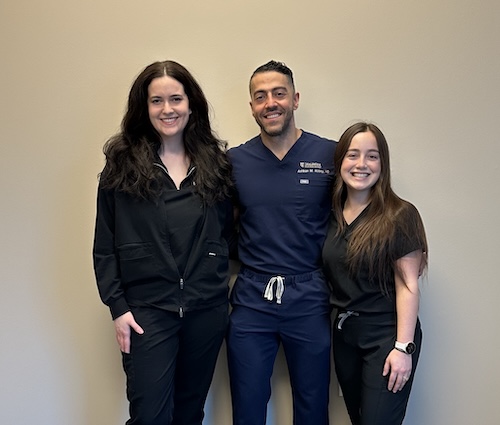Texas Retina’s Ashkan Abbey, MD; Paige Abril, BS; and Rachel McCullough, BS, recently published a retrospective study in the peer-reviewed journal Ophthalmic Surgery, Lasers and Imaging Retina titled, “Outcomes of Intravitreal Aflibercept 8 mg in Eyes with Neovascular Age-Related Macular Degeneration Previously Treated with Faricimab.”
Conducted in collaboration with colleagues at Wills Eye Hospital, Mid Atlantic Retina and Thomas Jefferson University, our Dallas research team explored the efficacy of intravitreal aflibercept 8 mg (Eylea HD) in treating patients with neovascular (wet) age-related macular degeneration (AMD) who previously received faricimab (Vabysmo) injections. Patients included in the study had experienced a suboptimal response to faricimab injections and had switched to intravitreal aflibercept 8 mg. The research team evaluated any changes in visual acuity and optical coherence tomography (OCT) features after the switch.
Key Findings of the Study
In the article, the researchers report that switching patients from faricimab to aflibercept 8 mg did not result in improvement in their visual acuity or an extension in treatment intervals. Central foveal thickness, an indicator of macular edema, decreased, but intraretinal fluid and subretinal hemorrhage (a build-up of blood under the retina) increased. Further studies were recommended.
“Despite promising results demonstrated in the clinical trials that lead to a drug’s approval, these studies primarily include treatment-naive patients, meaning they have not been previously treated for the condition,” explains Dr. Abbey. “However, in clinical practice, these drugs are often used after multiple doses of other injections for treatment-resistant cases. That is why it is important that we assess the real-world efficacy of switching to new treatments from traditional therapies. There were some limitations to our study, and we recommend further investigation to establish more conclusive guidelines for managing patients with wet AMD.”
Click here to read the full article.
Understanding Wet AMD and Current Treatment Options
The leading cause of vision loss in older American adults, AMD is the most common reason patients are referred to Texas Retina. It occurs when a part of the retina called the macula, the central part of the retina responsible for detailed vision, is damaged.
Dry AMD is characterized by accumulation of yellow deposits called drusen, thinning of the macula, and gradual deterioration of central vision. It can progress to wet AMD, a more serious form of the disease, where abnormal blood vessels grow under the retina and may leak. This can cause accumulation of blood or other fluid.
Faricimab (Vabysmo) is a monoclonal antibody delivered via intravitreal injection. Approved by the U.S. Food and Drug Administration (FDA) in January 2022, faricimab targets two pathways of wet AMD: vascular endothelial growth factor A (VEGF-A) and angiopoetin-2 (Ang-2). Both promote abnormal growth and leakage of blood vessels in the eye. Dr. Abbey has helped lead research on the drug and presented “The Real-World Efficacy and Safety of Faricimab in Neovascular Age-Related Macular Degeneration: The TRUCKEE Study – 2.5 Year Results” at the 57thAnnual Scientific Meeting of The Retina Society last September.
Aflibercept is an anti–vascular endothelial growth factor (anti-VEGF) agent designed to block the growth of new blood vessels and prevent fluid from passing through blood vessels in the eye. The U.S. Food and Drug Administration (FDA) approved the original formulation of Eylea, a 2 mg monthly intravitreal injection, in 2011. Eylea HD is a higher dose (8 mg), and was designed to be a longer acting formulation that would help patients maintain vision gains with fewer injections. It was approved by the FDA in August 2023 for the treatment of several retinal conditions, including wet AMD, diabetic macular edema (DME), and diabetic retinopathy.
Click here to learn more about wet AMD, including treatment options, or here to see our current clinical trials.


